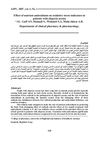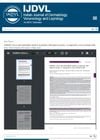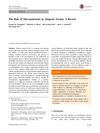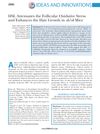TLDR Lower Paraoxonase 1 levels in alopecia areata patients suggest antioxidant treatment might help.
The study investigated the role of Paraoxonase 1 (PON1) in alopecia areata (AA) by measuring serum PON1 levels in 30 AA patients compared to 30 controls. Results showed a significant decrease in PON1 levels in AA patients (54.083 ± 25.464 μg/L) compared to controls (69.479 ± 17.012 μg/L), with a more pronounced decrease in males. The findings suggested an association between oxidative stress and the pathogenesis of AA, indicating that reducing oxidative stress could be a potential therapeutic approach, and recommending the use of antioxidant drugs for treatment.
66 citations
,
May 2011 in “Dermatologic therapy” Guidelines help design better trials to compare alopecia areata treatments.
286 citations
,
August 2007 in “Journal of Clinical Investigation” Alopecia areata is an autoimmune disease where T cells attack hair follicles.
 1 citations
,
June 2007 in “Almustansiriya journal of pharmaceutical sciences/Al-Mustansiriyah journal of pharmaceutical sciences”
1 citations
,
June 2007 in “Almustansiriya journal of pharmaceutical sciences/Al-Mustansiriyah journal of pharmaceutical sciences” Antioxidants can help improve hair growth in people with alopecia areata.
15 citations
,
January 2023 in “Antioxidants” Oxidative stress plays a significant role in alopecia areata, and new treatments may include JAK inhibitors and antioxidants.
 3 citations
,
July 2022 in “Indian journal of dermatology, venereology, and leprology”
3 citations
,
July 2022 in “Indian journal of dermatology, venereology, and leprology” Patients with alopecia areata have higher oxidative stress and lower antioxidant levels.
 63 citations
,
May 2017 in “American Journal of Clinical Dermatology”
63 citations
,
May 2017 in “American Journal of Clinical Dermatology” People with alopecia areata often have lower levels of vitamin D, zinc, and folate, but more research is needed to understand if supplements can help treat it.
November 2021 in “International Journal of Trichology” Low PON1 levels may indicate and predict the severity of hair loss.
 6 citations
,
October 2013 in “Plastic and Reconstructive Surgery – Global Open”
6 citations
,
October 2013 in “Plastic and Reconstructive Surgery – Global Open” HSL treatment speeds up hair growth and reduces oxidative stress in hair follicles of ob/ob mice.



